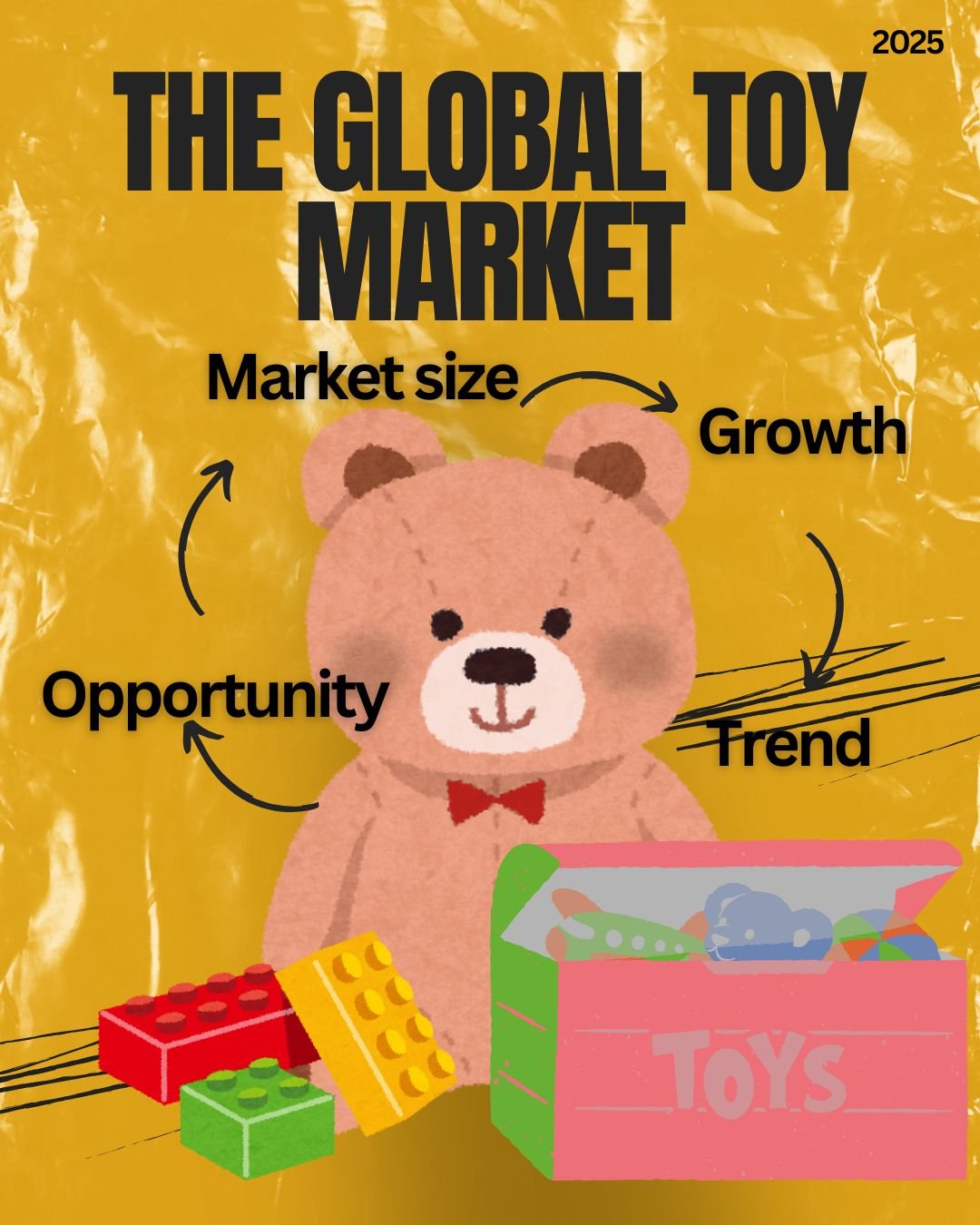Blogs
World Toys Market: Know Global Perspective

In this article, we’ll explore just how large the global toy market is, supported by internet research. You’ll understand the profitability and scale of the toy industry, and why the forecasted surge in demand for STEM toys and smart toys presents a major opportunity for toy manufacturers worldwide.
India: A Growing Domestic Giant
The Indian toy market has experienced dramatic change in recent years. According to IMARC, the market was valued at US $1.7 billion in 2023, projected to grow to US $4.4 billion by 2032 at a 10.6% CAGR. Earlier data from IBEF indicates the market was US $1.5 billion in 2022, expected to hit US $3 billion by 2028 —a telling sign of rapid expansion.
India’s toy manufacturing scene remains largely SME-driven: about 1,250 small producers dominate a sector where 90% is unorganised and the organised segment constitutes around 10%. Geographic clusters across Delhi–Noida, Mumbai, Kolkata, Chennai, and Karnataka illustrate widespread capacity.
A decade ago, over 85% of toys sold in India were imported—mostly from China. Import volumes have since halved: from US $332 million in 2014–15 to US $110 million in 2021–22—a 67% fall. By FY 2024, imports were US $65 million, with China’s share shrinking from 87% to 64%. Policy reforms such as stricter BIS standards, Quality Control Orders, and customs duty hikes—from 20% to 70%—are credited for this rapid swing.
Exports, meanwhile, surged by 239% between FY 2015 and FY 2023, making India a net exporter of toys. Exports rose from US $129.6 million to US $177 million in FY 2022, though FY 2024 saw a dip to US $152 million.
Traditional crafts like wooden toys and licensed brands coexist with a growing organised industry. The ‘Make in India’ push, BIS approvals, and subsidies have substantially supported this growth.
📌 Summary – India:
Exports: Up 239% since FY15; net exporter.
Market size: US $1.7 billion (2023), projected US $4.4 billion (2032).
Manufacturers: ~1,250; 90% unorganised.
Imports: Slashed ~67% over 10 years; China remains top but shrinking—64%.
United States: The Largest Global Toy Powerhouse
The US remains the top toy market globally. According to Grand View, North America’s smart toy market (dominated by the US) was valued at US $4.7 billion in 2024 and is growing at a 14.6% CAGR through 2034. Meanwhile, the overall global smart toys market reached US $12.37 billion in 2023, projected to rise to US $25.5 billion by 2030 (10.9% CAGR).
STEM toys are another US stronghold: North America held around 35% of the global STEM toys market in 2024, with the US responsible for about 80% of that share.
In traditional toys, licensed properties dominate. Circana reports that licensed toys made up 34% of US sales, with Pokémon, Barbie, Marvel, Hot Wheels, and Star Wars leading. Additionally, adults—dubbed the “kidult” market—comprise 17.3% of toy sales (US $6.7 billion) in 2023.
The US relies heavily on imports. While precise figures vary, most toys are imported from China, Mexico, and Vietnam. Even Lego has pivoted to opening new branded stores, reflecting global supply chain shifts.
📌 Summary – USA:
Licensed toys: 34% of the market; “kidult” segment strong.USA: The World’s Largest and Tech-Forward Toy Market
Smart toys: US $4.7 billion (2024); 14.6% CAGR to 2034.
Global smart toys: US $12.4 billion (2023), doubling by 2030.
STEM toys: US dominates with ~80% of North American share.
Europe: Mature, Diverse & Educationally Driven
Europe accounts for 30.7% of the global smart toys market, earning US $3.8 billion in 2023, with growth to US $7.95 billion by 2030 at an 11.1% CAGR.
Regionally, Germany, the UK, and France lead Europe’s smart toy sales—28 million units in 2024, forming 23% of global shipments. European smart toys often feature eco‑friendly materials and multilingual/safety features.
In STEM toys, Europe holds about 24% of the global market (2024). The European market prioritises educational value, evident in deals like ThreeSixty Group’s distribution of Discovery Toys.
Generally, Europe imports from China and regional neighbours, though internal manufacturing is significant in Germany, UK, and France.
📌 Summary – Europe:
- Smart toys: US $3.8 billion (2023); 11.1% CAGR to 2030.
- Shipments: 28 million units (23% global volume).
- STEM toys: ~24% global share.
- Market traits: Education‑driven, eco‑aware, multilingual.
Canada: A Small but Rapidly Growing Market
The Canadian toys market generated US $390.2 million in 2022 and is forecasted to reach US $603.7 million by 2030 (5.6% CAGR). A broader projection places the market at US $7.10 billion in 2025 with a 4.4% CAGR through 2029.
Revenue per capita in 2025 is anticipated at US $180. In Canada, offline channels generated 75% of toy revenues in 2022, yet online sales are expanding fastest.
Smart-toy sales are booming in Canada, with a projected 14.2% CAGR between 2025–2034. Educational robotics and STEM-play growth reflects parental interest in programming and critical thinking.
Domestic manufacturing is modest—US $146 million in output for toy/doll/game manufacturing in 2024, spread among ~385 companies. That industry had a slight growth rate (0.3% CAGR, 2018–2023). Hobby/toy store retailing saw CAGR 4.6% over five years, totalling US $8.2 billion in 2023.
The action-figure market alone hit US $318.9 million in 2022, forecast to reach US $646.6 million by 2030 (9.2% CAGR).
England (UK): A Mature, Collectible-Driven Market
The UK toy market was valued at approximately US $13.95 billion in 2024 and is forecast to reach US $19.29 billion by 2032 (4.1% CAGR). Growth is being driven by educational STEM toys, sustainable materials, and an increase in smart toys and online sales.
Moreover, the adult ‘kidult’ collectibles market has expanded rapidly, reaching £1 billion—about US $1.25 billion in recent years. Of that, £510 million (~US $640 million) relates to collectibles like blind boxes and anime figures. Retro toy relaunches (Care Bears, Tamagotchi, Subbuteo) highlight the market’s nostalgia-driven dimension.
Toy manufacturing in the UK is supported by companies such as Smyths (104 stores in England, plus Ireland and Scotland). Many producers emphasise sustainability, in line with parent and environmental demand .
🌍 Global Market & Rising Opportunities
Worldwide, the toy market was roughly US $114 billion in 2024 and is expected to reach US $203 billion by 2034 . Key expansion drivers include:
- Smart toys & AI: projected to reach US $50 billion by 2032, with a 16% CAGR .
- STEM toys: especially popular in North America and Europe; demand for educational, screen-free play remains high.
- Kidult collectibles: robust adult purchasing trends in the UK, US and globally.
🎯 What This Means for Toy Manufacturers
- Tap into Smart & AI-Enhanced Toys
Rapid growth in smart toys across US, Europe, Canada—manufacturers offering AI-enabled play have strong upside. - Invest in STEM & Educational Toys
Parents globally seek toys that promote learning, especially science, coding, and creativity. - Embrace Local Production
Markets such as India show reduced imports and greater domestic share yield faster growth and supply resilience. - Target Kidult & Collectibles
Adults are buying toys—especially collectibles—worth billions annually; nostalgia is a strong sales driver. - Utilise Online Channels
With rising e‑commerce penetration in Canada, the UK, and worldwide, digital-first distribution is essential.
📝 Conclusion
The global toy market is a tremendous global opportunity—projected to nearly double to US $203 billion by 2034. Each market—India, USA, UK, Canada—carries unique traits: from India’s growing domestic base to Canada’s rising online and STEM demand, to the UK’s collectible-driven market, and the US’s scale in smart and licensed toys.
For forward-thinking manufacturers, the time is ripe to innovate—through smart toys, STEM learning, and kidult collections. The intersection of technology, locality, and interactivity spells a bright future for the toy industry. Today’s manufacturers can build not only toys but future-thinking brands.








